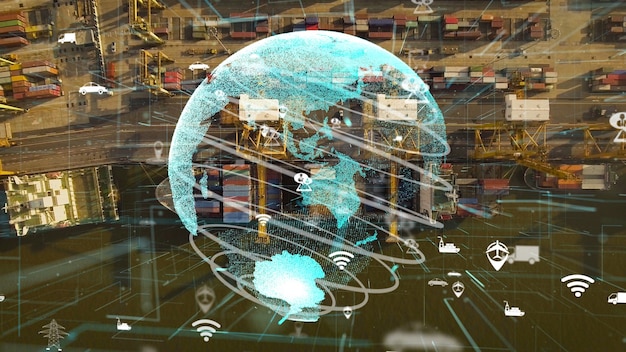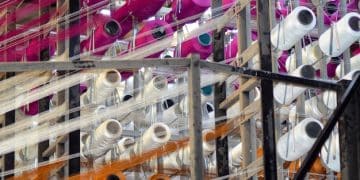AI Revolutionizing Fashion Design in the US Market

Artificial intelligence is quickly transforming every facet of the U.S. fashion industry, from design conception and supply chain optimization to trend forecasting and personalized customer engagement, ultimately fostering greater efficiency and innovation across the sector.
The landscape of fashion design within the U.S. market is undergoing an unprecedented transformation, largely driven by the pervasive advancements of artificial intelligence. This shift promises not only efficiency gains but also fundamentally redefines creativity and consumer interaction. As AI integrates deeper into the industry, understanding its multifaceted impact becomes crucial for designers, brands, and consumers alike.
The Dawn of Algorithmic Creativity
The traditional image of a fashion designer sketching tirelessly by hand is rapidly evolving. Today, artificial intelligence is stepping into the creative process, offering tools that can generate novel designs, patterns, and even entire collections with remarkable speed and precision. This doesn’t necessarily diminish human ingenuity but rather augments it, pushing the boundaries of what’s possible.
AI’s initial foray into design centered on algorithms capable of analyzing vast datasets of existing fashion, identifying recurring patterns, silhouettes, and aesthetic preferences. This analytical power allows AI to discern micro-trends and predict shifts long before they become visible to the human eye. Such capabilities move beyond mere trend spotting; they actively inform the generative design process itself.
AI-Powered Design Generation
Generative AI models, such as Generative Adversarial Networks (GANs), are at the forefront of this revolution. These systems can produce original designs based on specific parameters provided by designers, or even create entirely new concepts from scratch. Imagine an AI generating hundreds of unique sleeve designs or proposing innovative ways to incorporate sustainable materials into a garment.
- 👗 Conceptualization & Sketching: AI tools provide designers with a boundless well of ideas, generating initial sketches and concepts that designers can then refine.
- 🎨 Pattern & Print Creation: Algorithms can create intricate and repetitive patterns, or even abstract digital prints, custom-tailored to specific fabric types.
- 🧵 Material Optimization: AI assists in selecting the most suitable materials based on desired drape, wearability, and sustainability metrics.
This process is not about replacing human designers but empowering them. Designers can use AI as a co-creator, experimenting with countless variations in a fraction of the time it would take manually. It allows for rapid prototyping of ideas, reducing the time and resources typically spent in the initial design phase. The collaborative potential between human ingenuity and artificial intelligence is unlocking new avenues for creative expression within the U.S. fashion landscape.
Ultimately, the algorithmic creativity heralded by AI allows U.S. fashion designers to explore unprecedented stylistic avenues and respond with unparalleled agility to market demands. This shift is equipping brands with tools to be more innovative and competitive, enabling them to bring unique designs to market faster than ever before.
Predictive Analytics: Anticipating Consumer Desires
Beyond design, AI’s prowess in predictive analytics is reshaping how U.S. fashion brands foresee upcoming trends and consumer demand. This capability minimizes costly overproduction and ensures that what is produced genuinely resonates with the target audience. The traditional trend forecasting methods, often relying on intuition and aggregated historical data, are now being augmented, and at times supplanted, by hyper-accurate AI models.
AI algorithms sift through massive quantities of data, including social media sentiment, search query volumes, fashion show analyses, retail sales data, and even macroeconomic indicators. By identifying correlations and emerging patterns that are invisible to human analysts, AI provides a granular view of consumer preferences and market direction.
Enhanced Trend Forecasting
The precision afforded by AI in trend forecasting profoundly impacts inventory management and product development cycles. Brands can predict not only what colors or silhouettes will be popular, but also which specific fabrics, price points, and marketing messages will resonate in different regions or demographics within the U.S. market.
- 📈 Micro-Trend Identification: AI detects subtle shifts in consumer behavior and preference that indicate nascent trends, offering a competitive edge.
- 🛍️ Demand Prediction: Accurate forecasts help optimize production volumes, reducing waste from unsold inventory and preventing stockouts of popular items.
- 📊 Consumer Sentiment Analysis: AI monitors social media and online discussions to gauge public reaction to new collections, campaigns, or social issues impacting brand perception.
This deep understanding allows U.S. retailers and brands to make data-driven decisions ranging from sourcing raw materials to planning marketing campaigns. Instead of reacting to trends, they can proactively anticipate them, allowing for a more strategic and efficient allocation of resources. The result is a much leaner, more adaptive supply chain and a higher probability of producing exactly what consumers want, when they want it.
The ability to anticipate consumer desires with such accuracy means less speculative production, lower environmental impact due to reduced waste, and ultimately, higher profitability for U.S. fashion businesses. This shift from reactive to proactive strategies is a cornerstone of AI’s revolutionary impact on the industry.
Optimizing the Supply Chain and Production
The fashion supply chain is notoriously complex, spanning global networks from raw material sourcing to final product delivery. AI is proving to be a game-changer in streamlining these intricate processes, enhancing efficiency, transparency, and sustainability across the U.S. fashion market. By leveraging machine learning models, companies can gain unprecedented insights into their operations.
From predicting potential disruptions to optimizing logistics routes, AI offers solutions that lead to significant cost savings and improved delivery times. It’s about creating a more resilient and agile supply chain that can respond effectively to unforeseen challenges, whether they be geopolitical events, natural disasters, or sudden shifts in consumer demand.
Intelligent Logistics and Inventory Management
One of the most immediate benefits of AI in the supply chain is its capacity for sophisticated inventory management. Predictive analytics, driven by AI, can forecast demand with remarkable accuracy, allowing brands to maintain optimal stock levels—neither too much nor too little. This minimizes holding costs and reduces the risk of markdowns due to overstocking.

Moreover, AI algorithms can optimize logistics by identifying the most efficient shipping routes, consolidating shipments, and predicting potential delays. This leads to faster delivery times and a lower carbon footprint, aligning with growing consumer demand for sustainable practices.
- 📦 Warehouse Automation: Robotics and AI-powered systems can manage warehouse operations, including picking, packing, and sorting, with increased speed and accuracy.
- 🚚 Route Optimization: AI analyzes traffic patterns, weather, and delivery schedules to determine the most efficient transportation routes, reducing fuel consumption and costs.
- 🔄 Reverse Logistics: AI helps manage returns more effectively, identifying patterns in returns to improve product quality and customer satisfaction.
In addition, AI-powered quality control systems can monitor production lines to detect defects in real-time, preventing faulty items from reaching consumers and reducing waste. This level of oversight ensures higher product quality and consistency, which is crucial for brand reputation in the competitive U.S. market.
The integration of AI throughout the supply chain is transforming it from a series of disconnected steps into a cohesive, intelligent network. This intelligence empowers U.S. fashion brands to operate with unparalleled efficiency, reduce their environmental impact, and respond dynamically to market changes, establishing a new paradigm for operational excellence.
Personalization at Scale: The Future of Retail
The U.S. fashion consumer of today expects more than just clothing; they seek experiences and products that feel tailor-made for them. Artificial intelligence is enabling a level of personalization previously unimaginable, shifting the focus from mass-market offerings to bespoke recommendations and highly targeted interactions. This move deepens customer engagement and significantly boosts sales conversion rates.
AI achieves this by analyzing vast amounts of individual customer data, including browsing history, purchase patterns, social media activity, and even real-time physical interactions with products. This holistic view allows brands to understand individual preferences and predict future desires with remarkable accuracy.
Tailored Experiences and Recommendations
From virtual try-on experiences to personalized styling advice, AI is transforming the online and in-store shopping journey. Recommendation engines are becoming increasingly sophisticated, suggesting not just similar items but complete outfits that align with a customer’s individual style profile and intended use.
- 👗 Virtual Try-On: AI and augmented reality (AR) enable customers to “try on” clothes virtually, reducing returns and enhancing confidence in online purchases.
- 🤝 Personalized Styling: AI-powered chatbots and virtual assistants offer immediate, tailored styling advice based on user preferences, body type, and occasion.
- 📧 Customized Marketing: Dynamic email campaigns and website content adapt in real-time to reflect individual customer interests, improving click-through and conversion rates.
Moreover, AI is facilitating hyper-segmentation of customer bases, allowing brands to craft marketing messages that resonate precisely with specific sub-groups. This moves beyond generic promotions to highly relevant communications, whether it’s an offer on a specific style a customer has viewed repeatedly or a notification about new arrivals from their preferred designer.
The impact of this personalization extends beyond sales to foster stronger brand loyalty. When customers feel understood and valued, they are more likely to return and become advocates for a brand. For the U.S. fashion market, where competition is fierce, creating these deep, individualized connections is no longer a luxury but a necessity for survival and growth.
Ultimately, AI-driven personalization is redefining the customer relationship, making every interaction feel unique and relevant. This bespoke approach cultivates loyal customers and transforms the retail experience into a highly engaging and efficient journey for shoppers across the nation.
Sustainability and Ethical Practices Accelerated by AI
The fashion industry faces increasing scrutiny over its environmental impact and ethical practices. Artificial intelligence is emerging as a powerful ally in the push for greater sustainability and transparency within the U.S. market. By providing data-driven insights and optimizing resource usage, AI helps brands reduce waste, conserve energy, and ensure more ethical production processes.
AI’s role in sustainability spans the entire lifecycle of a garment, from the initial design phase to end-of-life recycling. It shifts sustainability from a buzzword to an actionable strategy, offering tangible ways for U.S. fashion companies to minimize their ecological footprint and uphold responsible manufacturing standards.
Reducing Waste and Resource Consumption
One of the most significant contributions of AI is in minimizing textile waste. Through precise demand forecasting, brands can avoid overproduction. Furthermore, AI can optimize pattern cutting to minimize fabric scraps, and even design garments that are easier to recycle or repurpose at the end of their life cycle.

In production, AI monitors energy consumption and water usage, identifying areas for efficiency improvements. It can also help track the origin of materials, ensuring they come from ethical and sustainable sources, thereby enhancing supply chain transparency.
- ♻️ Circular Economy Facilitation: AI helps identify materials suitable for recycling and informs designs that accommodate end-of-life recovery of components.
- 🌍 Ethical Sourcing Tracking: Blockchain, often integrated with AI, provides immutable records of a product’s journey from raw material to retail, ensuring fair labor and sustainable practices.
- ⚡ Energy Efficiency: AI optimizes operational processes in factories to reduce energy consumption, from lighting and heating to machine utilization.
Beyond environmental factors, AI can also play a role in monitoring ethical labor practices. By analyzing production data and sensor inputs, AI systems can flag anomalies that might indicate unsafe working conditions or excessive hours, promoting transparency and accountability across the supply chain.
As consumer awareness and regulatory pressures grow, the adoption of AI for sustainability is no longer optional for U.S. fashion brands. It represents a strategic imperative that not only benefits the planet but also enhances brand reputation and appeals to a growing segment of environmentally conscious consumers.
Through informed decision-making and optimized processes, AI is empowering the U.S. fashion industry to lead the charge towards a more sustainable and ethical future, transforming good intentions into measurable impacts.
Challenges and the Path Forward for AI in US Fashion
While the transformative potential of AI in the U.S. fashion market is undeniable, its widespread adoption is not without challenges. These hurdles range from technological complexities and data governance concerns to ensuring human oversight and adapting traditional business models. Addressing these issues is crucial for realizing AI’s full promise.
The integration of AI requires significant investment in infrastructure, talent, and ongoing research and development. Smaller brands, in particular, may find these initial costs prohibitive, creating a potential divide between industry leaders and emerging players. Furthermore, the ethical implications of AI, especially concerning data privacy and potential algorithmic bias, demand careful consideration.
Navigating the AI Landscape
One of the primary challenges is data acquisition and quality. AI models thrive on vast, clean, and representative datasets. For the fashion industry, this means effectively collecting and structuring data from diverse sources, including sales, social media, customer interactions, and supply chain operations. Ensuring data privacy and compliance with regulations like GDPR or CCPA adds another layer of complexity.
- 🔒 Data Privacy & Security: Implementing robust measures to protect sensitive customer and proprietary data is paramount to building trust.
- ⚖️ Algorithmic Bias: Developers must actively work to mitigate biases in AI algorithms that could perpetuate discrimination in design, marketing, or hiring practices.
- 👨💻 Talent Gap: A shortage of skilled AI engineers, data scientists, and creative professionals who understand both fashion and technology poses a significant barrier to widespread adoption.
Moreover, the ethical implications of AI, particularly regarding creative ownership and potential job displacement, are active discussions. While AI can augment human creativity, clear guidelines are needed to define its role and ensure that human designers retain their intrinsic value and unique contributions.
Despite these challenges, the trajectory for AI in U.S. fashion is one of continued growth and integration. Brands are actively investing in AI capabilities, collaborating with tech companies, and fostering internal innovation hubs. Education and training will be key to bridging the talent gap, empowering the next generation of fashion professionals to work alongside AI rather than be replaced by it.
The path forward involves a strategic, cautious, yet ambitious approach. By proactively addressing the challenges, the U.S. fashion industry can harness AI to unlock unprecedented levels of creativity, efficiency, and sustainability, ensuring its continued relevance and leadership in the global market.
The Evolving Role of the Human Designer
As artificial intelligence takes on more analytical and even generative tasks within the fashion design process, a frequently asked question emerges: what happens to the human designer? Far from rendering them obsolete, AI is fundamentally changing the designer’s role, elevating them to a more strategic, visionary, and empathetic position within the U.S. fashion industry.
The human element—intuition, cultural understanding, emotional intelligence, and genuine storytelling—remains irreplaceable. AI may generate patterns or predict trends, but it cannot conceptualize the cultural significance of a collection, evoke a specific emotion, or infuse a design with the ineffable “soul” that resonates with consumers on a deeper level.
Designers as Curators and Visionaries
With AI handling the more repetitive or data-heavy aspects of design, human designers are freed to focus on higher-level creative pursuits. They become curators of AI-generated options, refining, synthesizing, and imbuing them with their unique artistic vision. Their role shifts from mere creation to concept development, brand narrative, and ensuring designs truly connect with human experiences.
- 🎨 Creative Direction: Designers provide the high-level artistic vision, guiding AI tools to align with brand identity and core values.
- 🌐 Cultural Interpretation: They translate nuanced cultural trends and sentiments into designs that resonate authentically with diverse consumer groups.
- 💡 Ethical Oversight: Designers ensure that AI-generated designs align with ethical production and sustainability goals, making conscious choices about resource use and impact.
Furthermore, designers will increasingly act as the bridge between technology and artistry. They will need to understand the capabilities and limitations of AI tools, effectively communicate their creative intent to algorithms, and interpret the AI’s outputs. This requires a new skill set that blends traditional design acumen with technological literacy.
The shift also emphasizes the importance of emotional intelligence in design. While AI can analyze data about what people buy, it struggles to understand *why* they buy certain things—the emotional connections, the feeling a garment evokes, or the narrative it tells. This is where the human designer’s empathy and intuition are paramount.
In essence, AI elevates the human designer from a craftsman to a grand architect of experiences. Their expertise in discerning true value, crafting compelling stories, and connecting on a human level ensures that fashion remains an art form deeply intertwined with human emotion and cultural expression within the dynamic U.S. market.
Investment and Innovation Hubs in the US Fashion AI Landscape
The revolutionary impact of AI on the U.S. fashion market is attracting significant investment and fostering vibrant innovation hubs across the country. From established tech giants to nimble startups, a dynamic ecosystem is emerging, dedicated to pushing the boundaries of what artificial intelligence can achieve in apparel and accessories. This influx of capital and talent signals a strong belief in the long-term potential of AI to redefine the industry.
Major cities like New York, Los Angeles, and Silicon Valley are becoming convergence points for fashion brands, AI researchers, and venture capitalists. These hubs facilitate collaboration, accelerate the development of new technologies, and foster a culture of experimentation that is essential for disruptive innovation.
Key Investment Areas and Emerging Technologies
Investment is flowing into various segments of fashion AI, including generative design platforms, advanced trend forecasting tools, personalized retail experiences, and supply chain optimization solutions. Companies are not just funding research but also acquiring AI-driven startups to integrate cutting-edge capabilities into their operations.
- 💰 Venture Capital: Significant investments are being made in fashion tech startups focusing on AI, particularly those offering scalable solutions for design, production, and retail.
- 🔬 R&D Initiatives: Large fashion conglomerates are establishing in-house AI labs and partnering with academic institutions to drive fundamental research and applied innovation.
- 🤝 Tech Partnerships: Collaborations between traditional fashion houses and AI technology providers are becoming common, pooling expertise and resources to overcome complex challenges.
Beyond capital, these innovation hubs are cultivating specialized talent. Universities are incorporating fashion tech and AI into their curricula, preparing a new generation of professionals equipped with hybrid skills. Accelerators and incubators are providing mentorship and resources to nascent AI fashion ventures, helping them refine their products and penetrate the market.
The focus is not just on improving existing processes but on conceptualizing entirely new business models. This includes AI-powered on-demand manufacturing, which could drastically reduce waste and lead times, or hyper-personalized subscription services driven by predictive AI.
The robust investment and collaborative spirit within these U.S. innovation hubs are critical drivers of AI’s accelerated development and adoption in fashion. This concentrated effort ensures that the industry remains at the forefront of technological advancement, continually evolving to meet future consumer demands and operational challenges.
| Key Aspect | Brief Description |
|---|---|
| 🎨 AI in Design | Generates concepts, patterns, and optimizes materials, augmenting human creativity. |
| 📊 Predictive Analytics | Forecasts trends and consumer demand, reducing waste and optimizing inventory. |
| 🔗 Supply Chain Optimization | Streamlines logistics, inventory, and production for efficiency and sustainability. |
| 👗 Personalization | Delivers tailored shopping experiences, from virtual try-ons to custom recommendations. |
Frequently Asked Questions about AI in Fashion
▼
AI is applied in fashion design to generate new patterns, silhouettes, and collections, analyze massive datasets for trend forecasting, and optimize material selection for efficiency and sustainability. It serves as a powerful co-creator, enabling designers to explore countless variations quickly and refine their concepts with data-driven insights, speeding up the creative process significantly.
▼
No, AI is not expected to completely replace human fashion designers. Instead, it augments their capabilities, allowing them to focus on higher-level creative tasks, strategic vision, and emotional storytelling. Designers evolve into curators, cultural interpreters, and ethicists, using AI tools to enhance their output while retaining the irreplaceable human touch of intuition and empathy in design.
▼
AI contributes to sustainability by enabling precise demand forecasting to reduce overproduction and textile waste. It optimizes pattern cutting to minimize fabric scraps, monitors energy and water consumption in factories, and helps track material origins for ethical sourcing. This data-driven approach allows U.S. fashion brands to make more environmentally responsible decisions throughout their supply chain.
▼
Key challenges for AI adoption include significant investment in technology and talent, ensuring high-quality and private data, mitigating algorithmic biases, and bridging the current talent gap between fashion and AI expertise. Ethical considerations regarding creative ownership and potential job displacement also need careful navigation as the industry progressively integrates AI.
▼
AI personalizes the customer experience by analyzing individual browsing and purchase histories to offer tailored product recommendations and styling advice. It powers virtual try-on experiences, predicts future preferences, and enables hyper-targeted marketing campaigns. This creates a deeply customized and engaging shopping journey that fosters stronger brand loyalty and significantly boosts sales conversion rates.
Conclusion: The Intelligent Thread Weaves the Future of Fashion
The integration of artificial intelligence is undeniably revolutionizing fashion design within the U.S. market, charting a course toward an industry that is simultaneously more efficient, innovative, and ethically conscious. From automating creative processes and accurately forecasting trends to optimizing global supply chains and delivering hyper-personalized consumer experiences, AI’s influence is profound and continues to expand. While challenges such as data privacy and the talent gap persist, the collaborative evolution between human ingenuity and artificial intelligence promises a future where fashion is more responsive, sustainable, and creatively boundless. The intelligent thread woven by AI is not just enhancing existing practices; it is fundamentally redefining the very fabric of American fashion, paving the way for unprecedented growth and exciting new possibilities for designers and consumers alike.





